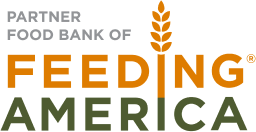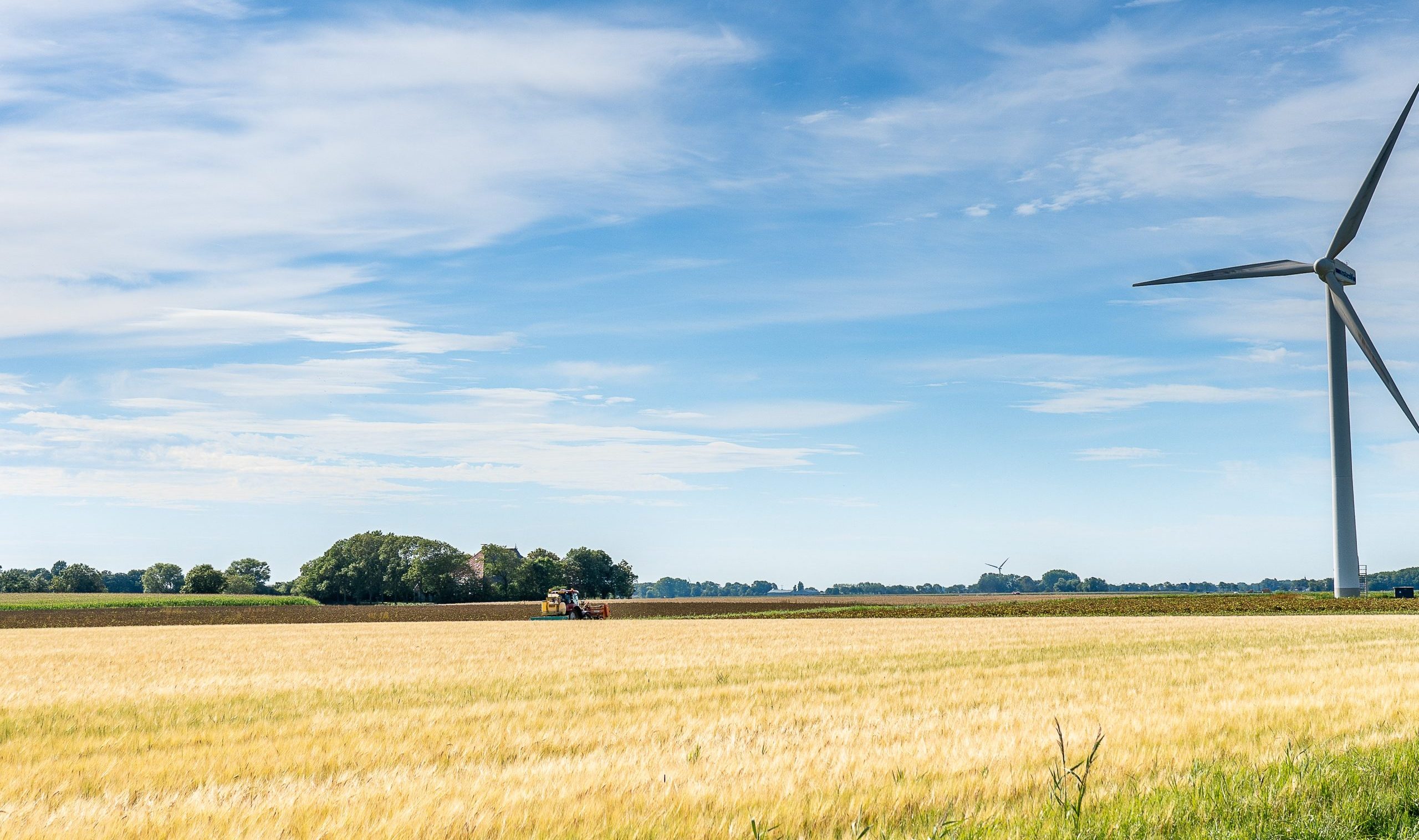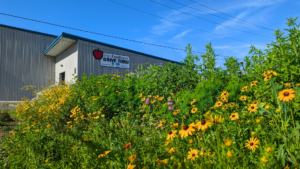Sustainable Food Systems
What They Are and How the Foodbank Contributes
By Amber Wright, Marketing Coordinator
When you sit down to enjoy a meal do you ever think about the steps it took for your food to reach your plate? Even before it is cooked in your kitchen, each of the ingredients undergoes a long journey of being grown, harvested, packaged, transported, stored, and sold. This process, known as a food system, is connected to many areas of life, affecting much more than just our waistlines.
A sustainable food system is a process of providing food security and adequate nutrition for all people in a manner that allows the cycle to continue for future generations. To determine whether or not a food system is sustainable there must be analysis in three main areas: economic, social and environmental impacts.
Economic Factors
For a food system to be economically sustainable it must provide benefits to participants at every stage of production.
Farmers must be able to make a living by growing food and raising animals or they might stop producing these basic staples. They must provide their workers a livable wage to harvest, package, prepare and ship their goods. After that, retailers need to make money from distributing the products throughout the community at affordable prices for consumers.
Ensuring profitability at all stages not only provides employment, but it also provides incentive for food to be distributed farther than the immediate area where it originated. Taxes generate revenue for local governments, while the food supply can reach even isolated communities.
National and international trade has allowed for a wider range of food options for countless people, but the system is not perfect in the United States or globally. Supply chain issues caused by the COVID-19 pandemic and the Russian-Ukraine war are a perfect example of how easily the current food system can be disrupted when there is an overreliance on imported goods and less utilization of locally sourced items.
Arguments surrounding the current minimum wage and tax systems vary in definition of what it means for workers to earn a sustainable living and how much companies are obligated to contribute to social welfare. Many researchers crunching the numbers have shown it is impossible for many minimum-wage workers to support themselves without government aid, while companies making record profits are accused of profiteering at the expense of consumers and employees alike.
Social Factors
For a food system to be socially sustainable it must have equitable distribution of all value produced in every stage of production. This covers many areas of human rights, such as regular access to healthy and nutritious food for consumers, labor rights for workers, and distribution of both food and employment to all demographics.
Enough food is produced globally to feed everyone in the world, but hunger persists because it is not distributed efficiently or equitably. An unreasonable amount of food goes to waste while people in all parts of the world struggle with food insecurity, malnutrition, or outright starvation.
Despite being among the wealthiest nations, countries like the US often contain numerous pockets of food deserts. These are areas with limited or no access to affordable and nutritious food. High crime rates, low-income averages and geographic isolation are a few of the factors that may deter grocery stores from setting up shop in certain neighborhoods because it is not seen as profitable. However, the effects on residents in these areas can be devastating.
Without a grocery store in the area people are often limited to the highly processed, low-nutritional foods commonly found at gas stations and dollar stores. Poor diets lacking essential vitamins and minerals are shown to lead to health problems. Sometimes a store might open in one of these areas, but inflated prices make it hard for people to get enough food for every meal. This further marginalizes a community in terms of poverty and health inequity, especially in low-income communities where barriers to transportation prevent travel to outside markets.
Food deserts are not the only element affecting public health. Streamlined, commercial production has greatly increased the presence of pesticides, antibiotics, and preservatives in food. All these things have negative health impacts when overconsumed. Mounting evidence also suggests that fruits and vegetables now contain fewer nutrients than they did in prior years.
Another aspect of social inequity within the food system is the distribution of employment and wages. The US, along with many countries across the globe, often displays systemic discrimination. Unemployment, low wages, and food deserts impact people of color more than white citizens. Jobs and resources are commonly denied because of race, gender, sexual orientation, religion, or background. If these intolerances persist, they will prevent regular access to a nutritious diet for entire communities.
Labor conditions also vary by industry and country. In some areas of the world labor laws do not exist to protect the health and safety of the workers. Even in the US there are frequent reports of health and safety violations, such as those cited at meat packing plants in Upton Sinclair’s famous book The Jungle. These violations can not only affect the well-being of the employees, but the condition and quality food being handled. Tainted food can easily cause the outbreak of disease among consumers.
Environmental Factors
For a food system to be environmentally sustainable it must have a neutral or positive impact on the surrounding natural environment. This covers many aspects of environmental conditions, such as plant and animal health, biodiversity, water quality, soil quality, carbon footprint, water footprint, food waste and toxicity.
Climate change and ecological destruction are widely known issues relating to current food systems. Agriculture is currently the second largest contributor of global greenhouse gas emissions, second only to the energy sector. Many harmful toxins are released in a variety of ways, such as the use of fertilizer, land drainage, the natural digestion of livestock and manure management. In addition, many farming methods are dependent on the use of fossil fuels to run industrial equipment.
Ecological destruction is readily seen in agricultural practices like deforestation for farmland, which eliminates entire ecosystems and limits biodiversity to a handful of crops. Pollution ranges from the burning of fossil fuels to the use of harmful pesticides and fertilizers. Industrial farming often leads to soil degradation and harmful additives to the groundwater.
Perhaps the most inexcusable problem of current systems is the amount of food that goes to waste. The UN estimates that 17 percent of total global food production is wasted each year. That equates to roughly 1.3 billion tons or $1 trillion. While some of this can be credited to poor harvesting techniques, more of it just goes bad from sitting unused for too long.
Food spoilage doesn’t just occur in the home of consumers. Food goes to waste on store shelves before it is sold, in the kitchens of restaurants or even during transit between places. The distance between the farm and the refrigerator of a consumer can be so great that a product may already nearing the end of its shelf-life when it arrives at a store. If it not sold, it oftentimes ends up being transported to a landfill.
The USDA identified 27 percent of the world population as food insecure prior to the COVID-19 pandemic. Not only is this food loss devastating to the millions of people struggling with hunger, it is also a waste of the water and energy used to produce it. According to the UN, the food wasted each year accounts for 38 percent of total energy usage in the global food system.
What We Do at The Foodbank
We do our best at The Foodbank to align our work as a charitable food organization with the goals of a sustainable food system; we work to provide regular access to nutritious foods for everyone, not just for today, but for all the days that follow.
We have made intentional efforts to foster socio-economic well-being for our employees, as well as the communities they serve. The Foodbank chose to place company headquarters in the 45417 ZIP code, which was identified as the area in Dayton with the highest concentration of poverty. As of last year, we have contributed more than $3.5 million in economic investment to the West Dayton area.
Recognizing that the minimum wage is not sustainable, our organization set base pay much higher to provide a livable wage. We also follow the four-day work week model so that families can make doctor appointments, attend school functions and meet other obligations without always having to miss work.
Benefits are provided at little-to-no cost because we value the health and well-being of every person within our Foodbank family. So far, The Foodbank has contributed more than $2.7 million in payroll alone during the 2021 fiscal year. Additional perks such as a gym membership, weekly yoga classes, compost bucket program membership and Gem City Market membership are also given free of charge.
Our reentry program provides employment to individuals who have previously had interactions with the criminal justice system and who might otherwise face barriers to entering the workforce. Not only does this grant meaningful employment, but it also reduces recidivism rates, benefitting the community, the employee and subsequent generations connected to them.
We strive to maintain diversity among our team and welcome all voices to the table, regardless of race, age, religion, gender, sexual preference or political beliefs. More than 690 hours were dedicated to Equity, Diversity, and Inclusion (EDI) training for our staff last fiscal year alone. We continue to focus on ways to incorporate this work in our operations.
Our community outreach might be the most recognizable work we do. Last fiscal year we distributed over 15 million pounds of food to more than 650,000 neighbors within our service area. We hold preference for locally sourced and nutritious foods, so 5.4 million pounds of our total was fresh produce harvested onsite or from local farms.
Some of our food sourcing is directly aimed at minimizing food loss. The “food rescue” program partners with retailers to acquire and distribute product that is nearing the end of its preferred shelf life. This prevents food from otherwise going to waste.
We have gone even further to reduce waste by incorporating our industrial composter. Food that spoils before distribution is turned into a rich compost to support plant growth in place of traditional fertilizers. We use this compost in our very own urban garden, which was created to provide fresh fruits and vegetables to the people we serve.
Our Beverly K. Greenehouse was recently added to provide fresh greens year-round. This structure was designed to catch and utilize rainwater, effectively lowering the overall water footprint. Along with the urban garden, this was built on an old gravel lot. Their creation turned concrete into a productive green space.
Last, but not least, we work to educate and advocate. Using our urban garden and hydroponic greenhouse, we demonstrate ways to grow food right here in the community and even pass out plants to the people in our lines so they can do the same. Volunteers and interns are given hands-on experience during our operations that can potentially translate into personal efforts at home.
References
Affairs, Current. “Many Of The Arguments Against Wealth Taxes Are Pathetic ❧ Current Affairs”. Current Affairs, 2019, https://www.currentaffairs.org/2019/11/bad-wealth-tax-arguments/.
“Antibiotics In Our Food System”. Foodprint, 2020, https://foodprint.org/issues/antibiotics-in-our-food-system/.
“Are Pesticides In Foods Harming Your Health?”. Healthline, 2021, https://www.healthline.com/nutrition/pesticides-and-health.
Bojorquez, Manuel. “Inflation Or “Corporate Greed”? Meat Prices Increased By Double Digits During Pandemic”. CBS News, 2022, https://www.cbsnews.com/news/meat-prices-pandemic-inflation-corporate-greed/. Accessed 22 July 2022.
“Can We Feed The World And Ensure No One Goes Hungry?”. UN News, 2022, https://news.un.org/en/story/2019/10/1048452.
“CDC And Food Safety”. CDC, 2022, https://www.cdc.gov/foodsafety/cdc-and-food-safety.html.
“Chemical Cuisine Ratings”. Center For Science In The Public Interest, 2021, https://www.cspinet.org/page/chemical-cuisine-ratings.
Chinni, Dante, and Paul Freedman. “The Socio-Economic Significance Of Food Deserts”. PBS Newshour, 2022, https://www.pbs.org/newshour/arts/the-socio-economic-significance-of-food-deserts.
“Climate Change Data | Climate Watch”. Climatewatchdata.Org, 2022, https://www.climatewatchdata.org/sectors/agriculture#drivers-of-emissions.
Egan, Matt. “Russia-Ukraine Crisis Replaces Covid As Top Risk To Global Supply Chains, Moody’S Says”. CNN Business, 2022, https://www.cnn.com/2022/03/04/business/russia-ukraine-supply-chain-oil/index.html. Accessed 22 July 2022.
“Fruits And Vegetables Are Less Nutritious Than They Used To Be.”. 2022, https://www.nationalgeographic.com/magazine/article/fruits-and-vegetables-are-less-nutritious-than-they-used-to-be#:~:text=Mounting%20evidence%20from%20multiple%20scientific%20studies%20shows%20that,C%20than%20those%20that%20were%20grown%20decades%20ago. Accessed 22 July 2022.
Gallion, Emily and Caitlyn McIntosh. “The Social Determinants Of Health: Connecting The Dots Between Race, Health Equity, And The Food Landscape”. The Foodbank, Inc. Blog, 2020, https://thefoodbankdayton.org/sdoh/. Accessed 1 Aug 2022.
“Industrial Agriculture Is Creating Serious Problems For Our Environment – Garden.Eco”. Garden.Eco, 2022, https://www.garden.eco/industrial-agriculture-creating-serious-problems#:~:text=While%20much%20of%20it%20is%20clean%20and%20pure%2C,mercury%2C%20lead%2C%20arsenic%2C%20and%20cadmium%20dissolved%20in%20it.
Livingston, Amy. “Living On The Minimum Wage – Is It Possible In 2022?”. Moneycrashers.Com, 2022, https://www.moneycrashers.com/living-on-minimum-wage-possible/.
Nations, United. “Food Loss And Waste Reduction | United Nations”. United Nations, 2022, https://www.un.org/en/observances/end-food-waste-day.
Nguyen, Hanh. “Sustainable Food Systems – Food and Agriculture Organization”. Food and Agriculture Organization , 10 Jan. 2018, https://www.fao.org/3/ca2079en/CA2079EN.pdf.
Project, The. “3 Ways Gainful Employment Reduces Recidivism – The Resource Project”. The Resource Project, 2021, https://theresourceproject.org/3-ways-gainful-employment-reduces-recidivism/.
ShelLin Erdman, CNN. “Global Food Waste Twice As High As Previously Estimated, Study Says”. CNN, 2022, https://www.cnn.com/2020/02/20/health/global-food-waste-higher/index.html#:~:text=The%20UN%20estimates%20annual%20global%20food%20waste%20at,directly%20linked%20to%20%22poor%20transportation%20and%20harvesting%20practices.%22.
Smith, Kelly Anne. “What You Need To Know About The Minimum Wage Debate”. Forbes, 2021, https://www.forbes.com/advisor/personal-finance/minimum-wage-debate/. Accessed 22 July 2022.
Smith, Michael D., and Birgit Meade. “Who Are The World’s Food Insecure? Identifying The Risk Factors Of Food Insecurity Around The World”. USDA, 2019, https://www.ers.usda.gov/amber-waves/2019/june/who-are-the-world-s-food-insecure-identifying-the-risk-factors-of-food-insecurity-around-the-world/.
“Sources Of Greenhouse Gas Emissions | US EPA”. US EPA, 2022, https://www.epa.gov/ghgemissions/sources-greenhouse-gas-emissions.
“Sustainable Food Systems”. CIAT, 2022, https://ciat.cgiar.org/about/strategy/sustainable-food-systems/.
United States Department of Agriculture. Characteristics And Influential Factors Of Food Deserts. 2012





No comment yet, add your voice below!